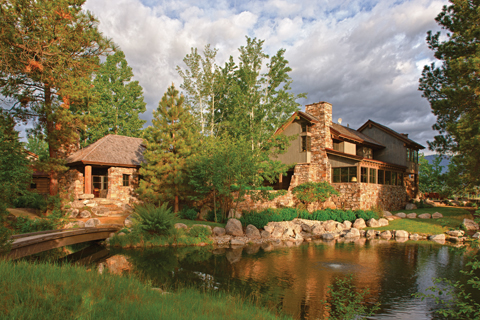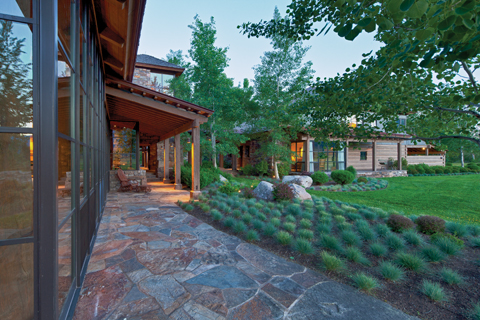An old saying tells us that the devil is in the details, but so is the dazzle! Landscaping and hardscaping your log or timber home put the finishing touch on the self-expression that motivates homeowners everywhere. Rather than an afterthought or an add-on, the exterior finish of the home and surroundings bring the vision to life and complete the journey from idea to reality. “It’s always important to mirror the theme of the log or timber frame home,” advises Tyler White, owner of Chattanooga Hardscapes in Chattanooga, Tennessee, “to bring the inside of the home outside while working with a contractor that takes pride in their work and wants people to see how passionate they are.”
Hardscaping involves the introduction of “hard” structures and accents to the exterior of the property, and these often include patios, pools, fireplaces, pergolas, outdoor kitchens, water features, stone walls, and other additions. White sees the popularity of several of these on the rise, along with the use of traditional building materials, particularly stone.
“We just finished a project that included 3,000 feet of hardscaping,” says Tyler, “and those items are always popular. We use a lot of travertine and natural flagstone. We ask our customers about their ideas and what they have in mind. Then we can make suggestions and follow up with color and pricing. It is important for the homeowner to have a budget in mind so that we know what to work with, and then we will provide them with two or three layout options before finalizing the plan.”
Some homeowners are looking at their properties with a flair for nostalgia, seeking landscaping with plants and accents that recall earlier days. “Log and timber home owners are often trying to recreate and give the feel of days gone by on their properties,” explains Pete Wilkerson, landscape architect and partner with the Scapes Group of Atlanta, Georgia. “With this said, we are seeing more use of ‘rustic,’ old-fashioned materials. Instead of concrete or poured walks, we are seeing large slabs of stone used for walks that are dry laid or set on grade. Furthermore, traditional old-fashioned plants and groundcovers are being used—not your typical foundation planting. Let the foundation of the home be seen. Use of native azaleas, hydrangeas, and liberal use of groundcovers is popular.”

Photo by Karl Neumann
With its natural water feature and exceptional stonework this home is reminiscent of a rustic English cottage. The landscaping is kept low to the ground with the exception of the native pines and aspens.
Another trend that Wilkerson sees is the movement toward low-maintenance and environmentally friendly landscaping. “Greater use of understory plants and perennials and less use of lawn and turfgrass will go a long way toward creating a lower maintenance and sustainable landscape,” he reasons. “Clients have even decided to create a vegetable garden and spend their time working that as opposed to the constant care of the landscape. Low maintenance is all about plant selection and minimizing the amount of maintainable items, such as lawns that have to be mowed and hedges or plants that flower and need deadheading.”
For log and timber home owners the process of developing a landscaping or hardscaping plan differs somewhat from the process involved with a conventional home. According to Jason Willard, owner of Mountain Construction Company and a member of the Fredonia Mountain Nature Resort Development Team in Dunlap, Tennessee, conventional homeowners typically favor symmetry while log and timber homeowners favor a more natural planting arrangement.
“Being a builder in the South, many of the conventional homes I build are designed in the traditional southern style,” Willard notes. “As such, so much of the design harkens back to our historical roots that were borrowed from the English garden, where symmetry and cutting gardens are predominant. Landscaping for log or timber frame construction draws from a historical context with a more natural approach that takes advantage of material that is native to the area. Look at pictures of log homes from the turn of the century, and you will see a well-tended garden in the back of the home and often fencing in the front awash in a sea of blue cornflowers in the open sun or wild blue phlox growing in the dappled light under a forest pansy redbud.”
Willard sees log and timber home landscaping as a powerful influence on the process in all construction genres. Homeowners are gravitating toward natural materials and products with an “aesthetic that appreciates and highlights” them.
It is indeed an exciting time to consider the prospects for the total log or timber home project and for homeowners to see landscaping and hardscaping as the jewel in their property’s crown.

